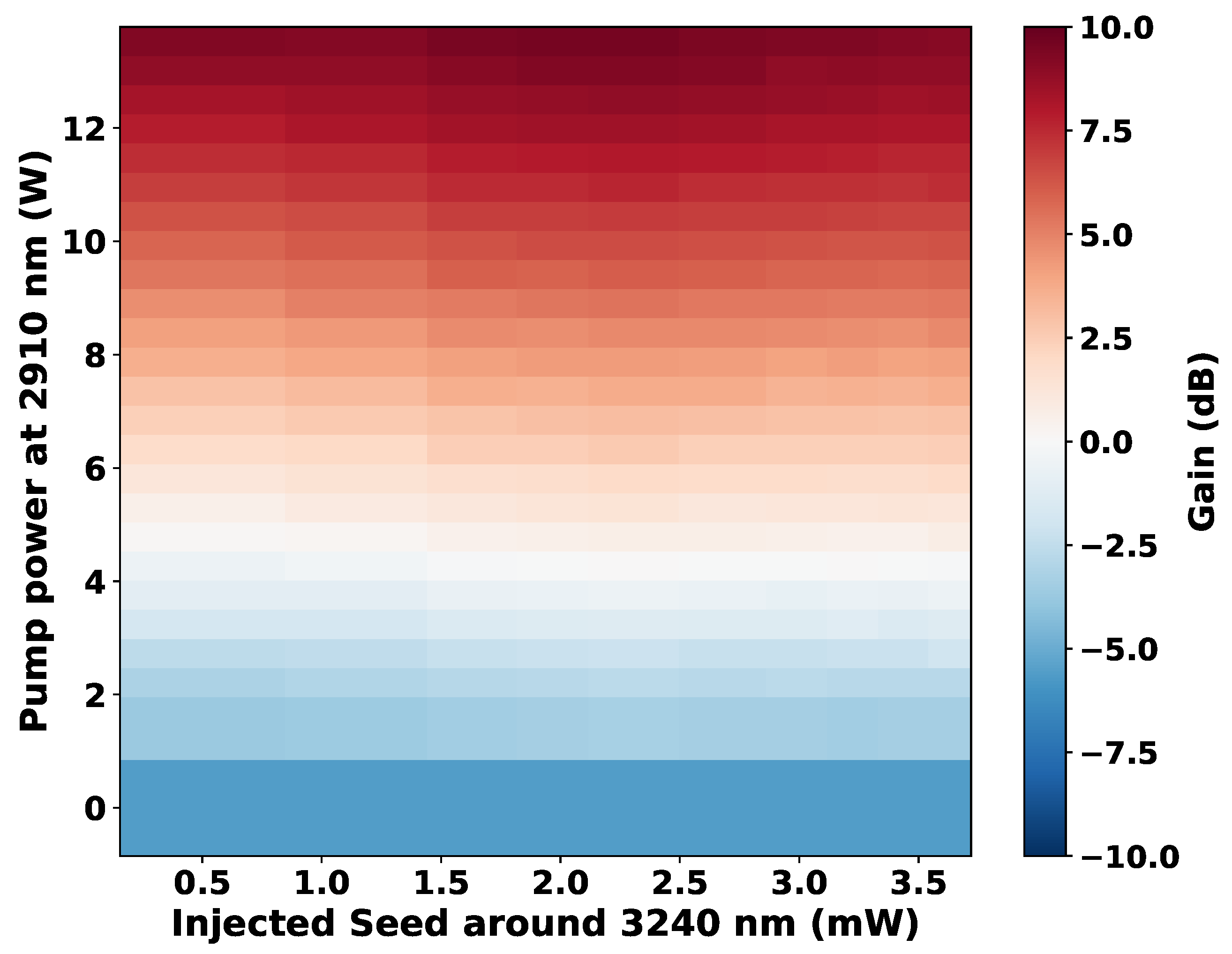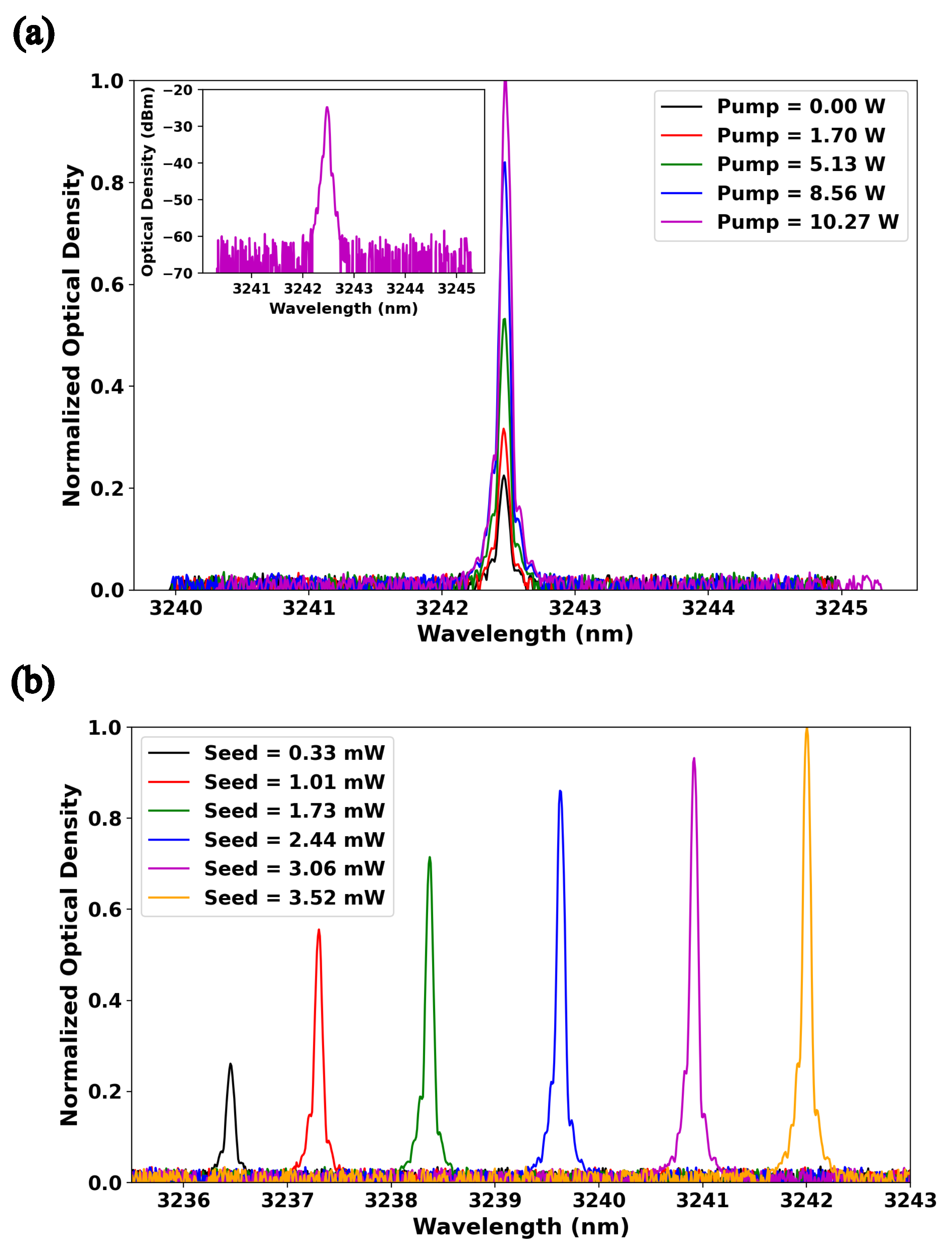Mid-Infrared Fiber Amplification of a DFB Interband Cascade Laser
Abstract
1. Introduction
2. Materials and Methods
3. Results
4. Discussion
5. Conclusions
Author Contributions
Funding
Data Availability Statement
Acknowledgments
Conflicts of Interest
References
- Gordon, I.; Rothman, L.; Hill, C.; Kochanov, R.; Tan, Y.; Bernath, P.; Birk, M.; Boudon, V.; Campargue, A.; Chance, K.; et al. The HITRAN2016 molecular spectroscopic database. J. Quant. Spectrosc. Radiat. Transf. 2017, 203, 3–69. [Google Scholar] [CrossRef]
- Toor, F.; Jackson, S.; Shang, X.; Arafin, S.; Yang, H. Mid-infrared Lasers for Medical Applications: Introduction to the feature issue. Biomed. Opt. Express 2018, 9, 6255–6257. [Google Scholar] [CrossRef]
- Murray, T.N.; Hu, J.K.; Friedman, P.M. Full-face and neck resurfacing with a novel ablative fractional 2910 nm erbium-doped fluoride glass fiber laser for advanced photoaging. Lasers Surg. Med. 2024, 56, 249–256. [Google Scholar] [CrossRef] [PubMed]
- Naithani, S.; Grisard, A.; Schaubroeck, D.; Lallier, E.; Van Steenberge, G. Mid-infrared resonant ablation of PMMA. J. Laser Micro/Nanoeng. 2014, 9, 147–152. [Google Scholar] [CrossRef]
- Jobin, F.; Paradis, P.; Aydin, Y.O.; Boilard, T.; Fortin, V.; Gauthier, J.C.; Lemieux-Tanguay, M.; Magnan-Saucier, S.; Michaud, L.C.; Mondor, S.; et al. Recent developments in lanthanide-doped mid-infrared fluoride fiber lasers [Invited]. Opt. Express 2022, 30, 8615–8640. [Google Scholar] [CrossRef]
- Majewski, M.R.; Bharathan, G.; Fuerbach, A.; Jackson, S.D. Long wavelength operation of a dysprosium fiber laser for polymer processing. Opt. Lett. 2021, 46, 600–603. [Google Scholar] [CrossRef] [PubMed]
- Westberg, J.; Teng, C.C.; Chen, Y.; Liu, J.; Patrick, L.; Shen, L.; Soskind, M.; Wysocki, G. Urban open-air chemical sensing using a mobile quantum cascade laser dual-comb spectrometer. APL Photonics 2023, 8, 120803. [Google Scholar] [CrossRef]
- Tittel, F.K.; Richter, D.; Fried, A. Mid-Infrared Laser Applications in Spectroscopy. In Solid-State Mid-Infrared Laser Sources; Springer: Berlin/Heidelberg, Germany, 2003; pp. 458–529. [Google Scholar] [CrossRef]
- Strahl, T.; Herbst, J.; Lambrecht, A.; Maier, E.; Steinebrunner, J.; Wöllenstein, J. Methane leak detection by tunable laser spectroscopy and mid-infrared imaging. Appl. Opt. 2021, 60, C68–C75. [Google Scholar] [CrossRef]
- Michaud, L.C.; Boilard, T.; Magnan-Saucier, S.; Paradis, P.; Talbot, L.; Thiboult, A.; Nadeau, D.F.; Vallée, R.; Bernier, M. Towards real-time active imaging of greenhouse gases using tunable mid-infrared all-fiber lasers. Appl. Opt. 2023, 62, G69–G76. [Google Scholar] [CrossRef]
- Koeth, J.; Weih, R.; Scheuermann, J.; Fischer, M.; Schade, A.; Kamp, M.; Höfling, S. Mid infrared DFB interband cascade lasers. In Proceedings of the Infrared Remote Sensing and Instrumentation XXV, San Diego, CA, USA, 30 August 2017; Strojnik, M., Kirk, M.S., Eds.; International Society for Optics and Photonics, SPIE: St. Bellingham, WA, USA, 2017; Volume 10403, p. 1040308. [Google Scholar] [CrossRef]
- Gong, J.; Yang, R.Q.; Wang, Z.; He, J.J. Single-Mode Tunable Interband Cascade Laser Emitting at 3.4 µm With a Wide Tuning Range Over 100 nm. IEEE Photonics Technol. Lett. 2023, 35, 309–312. [Google Scholar] [CrossRef]
- Ning, C.; Sun, R.X.; Man Liu, S.; Zhang, J.C.; Zhuo, N.; Liu, J.Q.; Wang, L.J.; Qiang Zhai, S.; Liu, F.Q.; Wang, Z.G. GaSb surface grating distributed feedback interband cascade laser emitting at 3.25 µm. Opt. Express 2022, 30, 29007–29014. [Google Scholar] [CrossRef]
- Borgentun, C.; Frez, C.; Briggs, R.M.; Fradet, M.; Forouhar, S. Single-mode high-power interband cascade lasers for mid-infrared absorption spectroscopy. Opt. Express 2015, 23, 2446–2450. [Google Scholar] [CrossRef] [PubMed]
- Xie, F.; Stocker, M.; Pham, J.; Towner, F.; Shen, K.; Wang, J.; Lascola, K. Distributed feedback interband cascade lasers with top grating and corrugated sidewalls. Appl. Phys. Lett. 2018, 112, 131102. [Google Scholar] [CrossRef]
- Vurgaftman, I.; Bewley, W.W.; Canedy, C.L.; Kim, C.S.; Kim, M.; Merritt, C.D.; Abell, J.; Meyer, J.R. Interband Cascade Lasers with Low Threshold Powers and High Output Powers. IEEE J. Sel. Top. Quantum Electron. 2013, 19, 1200210. [Google Scholar] [CrossRef]
- Aydin, Y.O.; Fortin, V.; Vallée, R.; Bernier, M. Towards power scaling of 2.8 µm fiber lasers. Opt. Lett. 2018, 43, 4542–4545. [Google Scholar] [CrossRef]
- Zhang, L.; Sheng, Q.; Fu, S.; Luo, X.; Zhang, J.; Shi, W.; Yao, J. 16.4 W mid-infrared Er: ZBLAN fiber laser at 3.5 µm. Chin. J. Lasers 2024, 51, 1816001. [Google Scholar] [CrossRef]
- Boilard, T.; Fortin, V.; Lemieux-Tanguay, M.; Paradis, P.; Teilleul, P.D.; Carrée, J.Y.; Vallée, R.; Bernier, M. 1.7 W holmium-doped fluoroindate fiber laser at 3920 nm. Opt. Lett. 2024, 49, 2677–2680. [Google Scholar] [CrossRef]
- Yu, L.; Liang, J.; Huang, S.; Wang, J.; Wang, J.; Luo, X.; Yan, P.; Dong, F.; Liu, X.; Lue, Q.; et al. Generation of single solitons tunable from 3 to 3.8 µm in cascaded Er3+-doped and Dy3+-doped fluoride fiber amplifiers. Photonics Res. 2022, 10, 2140–2146. [Google Scholar] [CrossRef]
- Michaud, L.C.; Boilard, T.; Vallée, R.; Bernier, M. Amplification of a Single-Frequency Interband Cascade Laser Around 3240 nm Using a Dysprosium-Doped Fluoride Fiber. In Proceedings of the 2025 Conference on Lasers and Electro-Optics Europe & European Quantum Electronics Conference (CLEO/Europe-EQEC), Munich, Germany, 23–27 June 2025; p. 1. [Google Scholar] [CrossRef]
- Annunziato, A.; Loconsole, A.M.; Francione, V.V.; Anelli, F.; Ressa, L.; Pisani, F.; Galzerano, G.; Prudenzano, F. Design of in-band pumped dysprosium-doped ZBLAN fiber amplifier for mid-IR wavelength range. In Proceedings of the Fiber Lasers and Glass Photonics: Materials Through Applications IV, Strasbourg, France, 20 June 2024; Taccheo, S., Cicconi, M.R., Jäger, M.L., Eds.; International Society for Optics and Photonics, SPIE: St. Bellingham, WA, USA, 2024; Volume 13003, p. 1300308. [Google Scholar] [CrossRef]
- Magnan-Saucier, S.; Duval, S.; Matte-Breton, C.; Aydin, Y.O.; Fortin, V.; LaRochelle, S.; Bernier, M.; Vallée, R. Fuseless side-pump combiner for efficient fluoride-based double-clad fiber pumping. Opt. Lett. 2020, 45, 5828–5831. [Google Scholar] [CrossRef]
- Fortin, V.; Bernier, M.; Bah, S.T.; Vallée, R. 30 W fluoride glass all-fiber laser at 2.94 µm. Opt. Lett. 2015, 40, 2882–2885. [Google Scholar] [CrossRef]
- Bernier, M.; Faucher, D.; Vallée, R.; Saliminia, A.; Androz, G.; Sheng, Y.; Chin, S.L. Bragg gratings photoinduced in ZBLAN fibers by femtosecond pulses at 800 nm. Opt. Lett. 2007, 32, 454–456. [Google Scholar] [CrossRef]
- Majewski, M.R.; Jackson, S.D. Highly efficient mid-infrared dysprosium fiber laser. Opt. Lett. 2016, 41, 2173–2176. [Google Scholar] [CrossRef] [PubMed]
- Norooz Oliaee, J.; Sabourin, N.A.; Festa-Bianchet, S.A.; Gupta, J.A.; Johnson, M.R.; Thomson, K.A.; Smallwood, G.J.; Lobo, P. Development of a Sub-ppb Resolution Methane Sensor Using a GaSb-Based DFB Diode Laser near 3270 nm for Fugitive Emission Measurement. ACS Sens. 2022, 7, 564–572. [Google Scholar] [CrossRef]
- Razavipour, S.G.; Gupta, J.A.; Sabiston, G.; Sabourin, N.; Bezinger, A.; Lapointe, J.; Poitras, D. Pressure-dependent sensitivity of a single-pass methane detection system using a continuous-wave distributed feedback laser at 3270 nm. Appl. Opt. 2019, 58, 6906–6911. [Google Scholar] [CrossRef]
- Carbonnier, C.; Többen, H.; Unrau, U. Room temperature CW fibre laser at 3.22 µm. Electron. Lett. 1998, 34, 893–894. [Google Scholar] [CrossRef]
- Fortin, V.; Jobin, F.; Larose, M.; Bernier, M.; Vallée, R. 10-W-level monolithic dysprosium-doped fiber laser at 3.24 µm. Opt. Lett. 2019, 44, 491–494. [Google Scholar] [CrossRef]





Disclaimer/Publisher’s Note: The statements, opinions and data contained in all publications are solely those of the individual author(s) and contributor(s) and not of MDPI and/or the editor(s). MDPI and/or the editor(s) disclaim responsibility for any injury to people or property resulting from any ideas, methods, instructions or products referred to in the content. |
© 2025 by the authors. Licensee MDPI, Basel, Switzerland. This article is an open access article distributed under the terms and conditions of the Creative Commons Attribution (CC BY) license (https://creativecommons.org/licenses/by/4.0/).
Share and Cite
Michaud, L.-C.; Boilard, T.; Vallée, R.; Bernier, M. Mid-Infrared Fiber Amplification of a DFB Interband Cascade Laser. Photonics 2025, 12, 988. https://doi.org/10.3390/photonics12100988
Michaud L-C, Boilard T, Vallée R, Bernier M. Mid-Infrared Fiber Amplification of a DFB Interband Cascade Laser. Photonics. 2025; 12(10):988. https://doi.org/10.3390/photonics12100988
Chicago/Turabian StyleMichaud, Louis-Charles, Tommy Boilard, Réal Vallée, and Martin Bernier. 2025. "Mid-Infrared Fiber Amplification of a DFB Interband Cascade Laser" Photonics 12, no. 10: 988. https://doi.org/10.3390/photonics12100988
APA StyleMichaud, L.-C., Boilard, T., Vallée, R., & Bernier, M. (2025). Mid-Infrared Fiber Amplification of a DFB Interband Cascade Laser. Photonics, 12(10), 988. https://doi.org/10.3390/photonics12100988




